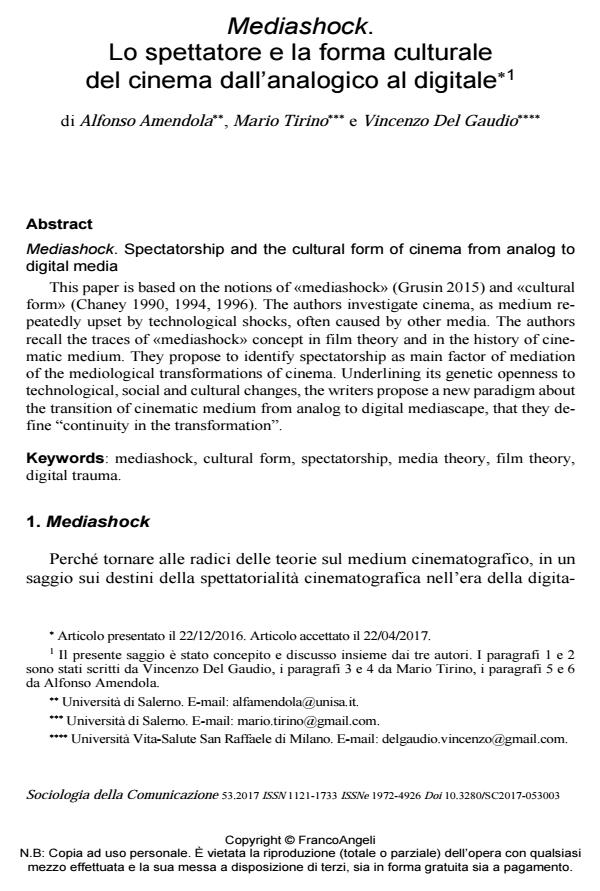Mediashock. Spectatorship and the cultural form of cinema from analog to digital media
Journal title SOCIOLOGIA DELLA COMUNICAZIONE
Author/s Alfonso Amendola, Mario Tirino, Vincenzo Del Gaudio
Publishing Year 2017 Issue 2017/53
Language Italian Pages 18 P. 25-42 File size 236 KB
DOI 10.3280/SC2017-053003
DOI is like a bar code for intellectual property: to have more infomation
click here
Below, you can see the article first page
If you want to buy this article in PDF format, you can do it, following the instructions to buy download credits

FrancoAngeli is member of Publishers International Linking Association, Inc (PILA), a not-for-profit association which run the CrossRef service enabling links to and from online scholarly content.
This paper is based on the notions of «mediashock» (Grusin 2015) and «cultural form» (Chaney 1990, 1994, 1996). The authors investigate cinema, as medium repeatedly upset by technological shocks, often caused by other media. The authors recall the traces of «mediashock» concept in film theory and in the history of cinematic medium. They propose to identify spectatorship as main factor of mediation of the mediological transformations of cinema. Underlining its genetic openness to technological, social and cultural changes, the writers propose a new paradigm about the transition of cinematic medium from analog to digital mediascape, that they define "continuity in the transformation".
Partendo dalla nozioni di "mediashock" (Grusin 2015) e di "forma culturale" (Chaney 1990, 1994, 1996), il paper si interroga sulla natura del cinema in quanto medium sottoposto a continui shock tecnologici. Gli autori ripercorrono dapprima il concetto di "mediashock" nelle teorie sul cinema e quindi procedono ad un’analisi media-archeologica degli shock provocati da altri media sulla struttura socioculturale e tecnologica del cinema. Proponendo di individuare nella spettatorialità il principale fattore di mediazione delle trasformazioni del medium cinematografico, gli autori propongono un nuovo paradigma, definito della "continuità nella rottura", attraverso il quale spiegare il transito del cinema dall’analogico al digitale.
Keywords: Mediashock, cultural form, spectatorship, media theory, film theory, digital trauma.
Alfonso Amendola, Mario Tirino, Vincenzo Del Gaudio, Mediashock. Lo spettatore e la forma culturale del cinema dall’analogico al digitale in "SOCIOLOGIA DELLA COMUNICAZIONE " 53/2017, pp 25-42, DOI: 10.3280/SC2017-053003